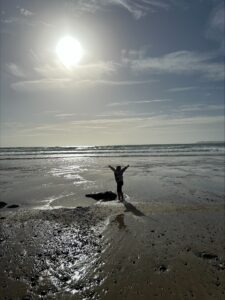The Old Way
I recently met as old man who told me of his life as a boy at Sandy Haven. He was proud to report that he and his family lived entirely off the land and sea. There were no supermarkets nor shops in those days and they were entirely self sufficient. But they did have the Sloop Inn pub on the beach that was locally famous for its cold beers and ciders in summer that were stored in a cellar cut into the rocks beneath it. He told me his father kept ferrets and they would go out hunting rabbits. Sunday dinner was usually a rabbit. Potatoes, black currents and raspberries were grown in the back garden. For turnips and cauliflowers they would help themselves to some of the farmers crops in nearby fields. He said the farmers did not mind, so long as the amounts removed were small and for their subsistence. His father would in return give the farmers a pair of rabbits now and again. The summer bounty was immensely important. Mushrooms were gathered in the fields of the Dale area. Apples were grown in local gardens. The family gathered the abundant summer blackberries and his mother used them to make pies, jams and wine. His mother also gathered elderberries to make elderberry wine. She also gathered sloes to make sloe gin for Christmas. Summer fruits could be preserved in jars for the long winter nights. On land with an air rifle there were more rabbits, pigeons (swabs) and rarely pheasants.
Equally important was the food they gathered from the sea. There were certain beaches and places where good catches could be had. They used 50 meter long tangle nets which are still legal today. These would be put out on an incoming tide, one hour after it started coming in on an evening. Early next morning as the tide fell they would be there gathering their fish from the net. They had a problem with the foxes that liked fish and were quick to seize any that the fishermen did not get to in time. The old man still remembers the one time he and his father gathered four boxes of bass fish from ‘Jubilee Beach’. They had a small boat and some lobster pots (three pots are allowed to each person today without a license). With these they caught crabs and rarely lobsters. In the summer it was the time for the mackerel to run and large numbers were caught. Some of these were preserved by smoking them. Others were shared out in the small community. The crossing at Sandy Haven (previously stepping stones but now a low footbridge) was a famous spot for catching shrimp and green crabs. The sand banks of the tidal creek were a source of cockles gathered by raking up the sand. Mussels were also gathered from the sea cliffs at low tide. Winkles were also gathered from the stones of stony beaches. Today a trade continues at Burrey Port where a half ton of cockles can be gathered by raking the extensive Cefn Sidan Sands visible from the train to and from Swansea.
During World War II food was rationed and ration books were issued. The ration allowed for one adult for one week was: a halfpenny worth of meat; 4 oz bacon; 4 oz cheese; 4 oz margarine; 2 oz butter; 2 oz lard; 8 oz sugar; 4 oz jam, 2 oz tea; and 5 points of rationed food – a tin of baked beans, 1 pound of lentils, and 3 oz spiced ham. Rationing continued until 1954 when meat come off the ration list. As a young boy in Milford Haven in the 1940’s and early 50’s I remember my mother’s rabbit pies. This was a pastry pie baked in a dish filled with rabbit meat, carrots, onions, potatoes and gravy. As meat was rationed there were enterprising rabbit catchers who created a black market selling rabbits to the meat hungry population.


